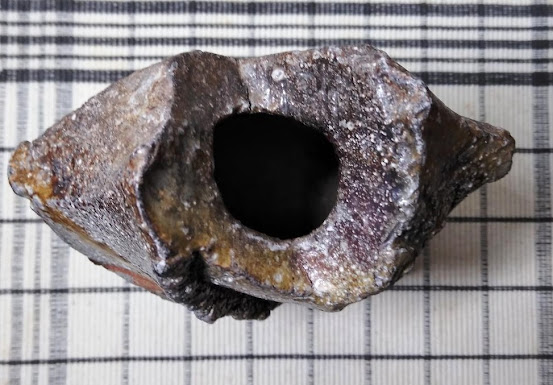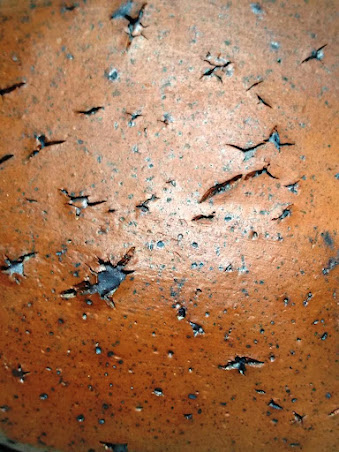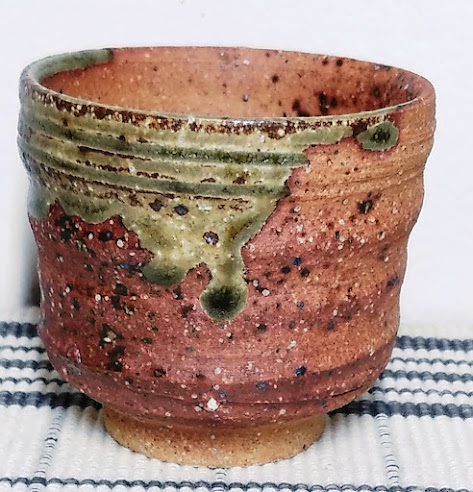225. FURUTANI Hiromu, 古谷弘, Chūroku 忠六 I, 1922-2012, 信楽自然釉土瓶花入 Shigaraki shizenyū dobin hanaire (Shigaraki teapot vase with natural ash glazing)
Furutani Hiromu was the father of Furutani Hirofumi 博文 (Chūroku 忠六 II) and grandfather of Furutani Taketoshi (see items no. 218 and 224), all potters in the Shigaraki tradition.
Gray clay, with kiln effects in the reddish brown, pink, gray, and black ranges, with vitrified natural ash glazing covering most of the exterior. Weight: 2 kg (4.5 lb). Height: 28 cm (11 in). Width (measuring from end of “handle” to widest diameter of body): 16.5 cm (6.5 in).
The upper portion of this is shaped like a kyusu teapot, with a “handle,” a “spout,” and a lid. Below this the body is drawn out into an elongated cylinder. The piece sits on the flat base. The base is roughly circular, 9.5 cm (3-3/4 in) in diameter, with irregular, bumpy edges. The remains of the three posts used to separate the piece from the shelf during firing are visible. The artist’s mark, the characters 忠六, was incised into the base with a pointed tool. A small white sticker with the number 64 attached to the base dates from this piece’s inclusion in the exhibit of the wares of the three generations of the Furutani family at the Kura Monzen Gallery in Kyoto, Japan, in 2023.
Above the base, the walls of the body proper move inward slightly in more or less a straight line to the narrowest point, 8.2 cm (3-1/4 in) in diameter and 5.7 cm (2-1/4 in) above the base. From there, the walls rise upward and outward in a gentle convex arc to the widest point, 10.7 cm (4-1/4 in) in diameter and 19.5 cm (7-3/4 in) above the base. The walls then move inward in a shallow convex arc to the neck, which is 8.2 cm (3-1/4 in) in diameter and 25.4 cm (10 in) above the base. The neck is about 3 cm (1-1/8 in) in height. It moves inward slightly before flaring outward to the rim. The body is encircled with grooves. Near the top, there are deeper incisions, and there is a decided break at the neck. The surface is generally smooth, with rougher places of ash deposits.
The “handle” is a rough cylinder, 5.7 cm (2-1/4 in) long and about 3.2 cm (1-1/4 in) wide at the end. The cylinder gets narrower as it approaches the body proper. The handle begins 18.3 cm (7-1/4 in) above the base. It was formed separately and attached by being pressed into the side of the piece. The hole in the outer end is only about 1.3 cm (1/2 in) deep. The “spout” is set ninety degrees to the left of the spout. It is about 5 cm (2 in) long and 4.2 cm (1-5/8 in) wide at the mouth. It begins about 17 cm (6-3/4 in) above the base. It is an oval cylinder in shape and, like the handle, was formed separately and attached by being pressed into the body proper. The spout is hollow its entire length, but there is no opening through the walls proper into the interior of the piece, as there would be in a kyusu. It would be impossible, and unwise, to pick the piece up by the handle.
The lid sits on a flange encircling the mouth, about 1.3 cm (1/2 in) below the rim. It nestles into the opening securely; in one spot a protrusion on the inside of the rim matches up with an indentation on the side of the lid. The base of the lid is flat. The remains of the three posts used to separate the lid from the shelf during firing are visible on the underside. The upper surface is a shallow dome with a small topknot in the center functioning as a place to grasp the lid. The upper surface features an inwardly spiraling groove.
This was not glazed before firing. With the exceptions of the spots where the posts were, the base and the underside of the lid were scorched pinkish red by the firing but not covered by the natural ash glaze except near the edges. The portion of the body proper beneath the handle and spout is black in color; this area also has the heaviest ash deposits and hence the roughest texture. The back (the side opposite the spout) is reddish-brown in color and much speckled with gray dots. The rest of the vase and the lid are a greenish gray. The colors result from kiln effects and a heavy deposit of natural ash glazing. On the lid and over most of the surface of the exterior the natural ash glaze vitrified to form a glossy surface. The interior shows some colors from the firing in the red and black ranges but has none of the vitrified ash glaze.
This came with an orange cloth (unstamped), a printed sheet with the artist’s biography, and a booklet from the Kura Monzen Gallery exhibition. It came with a box, inscribed by Furutani Taketoshi. The inscription in five lines reads from right to left: 信楽 Shigaraki 自然釉 shizenyū (natural ash glaze) 土瓶 dobin (pottery teapot) 花入 hanaire (vase) 初代 shodai (first generation) 忠六 Chūroku, followed by the artist’s seal in red (again reading 忠六 Chūroku).
I don’t know if I would call this a vase if the piece hadn’t been so labeled. Its design is certainly unique in its fusion of two separate genres of Japanese pottery—a small teapot and a flower vase. It is a solid piece and a testament to the artist’s imagination and skills in shaping and firing. Unlike many potters of his generation, Furutani Hiromu was willing to push the boundaries of shape.
Purchased
from the Kura Monzen Gallery (modernjapaneseceramics.com), Kyoto, Japan, July
2023.



























































